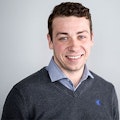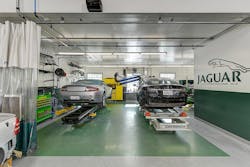Kye Yeung stopped everything he was doing when he found out. For the next few days, he mopped the shop floor, tidied the lobby, planted flowers out front—doing everything he could to make European Motor Car Works as presentable as possible.
Everything was going great—until his guests showed up one day early.
“I had on shorts and a T-shirt,” Yeung says, “and these dudes with black trench coats walk up. They wanted to see the real me, and were amazed by my shop. That’s when I got my first certification.”
Those men in the black trench coats? They were representatives from Aston Martin—one of the luxury automakers for which Yeung was desperate to get on the certification program.
Embarrassed and relieved at the same time, this moment captures what has set Yeung’s Costa Mesa, Calif., operation apart from the very beginning: the willingness to work with OEMs and offer a facility that caters to their expectations for collision repair.
And he truly cared about those expectations: Born in Hong Kong and a British citizen during his youth, British automobiles were Yeung’s passion for years, and he couldn’t dream of working on anything else when he first opened a 1,600-square-foot restoration shop back in 1975.
Just one year earlier, 70 percent of all dealerships had body shops. Today, that number stands at 40 percent, reports Wards Auto. So when the people from luxury automakers like Aston Martin, Jaguar, Range Rover and Tesla stop by the shop, they expect a facility that lives up to dealership expectations—and Yeung delivers.
But here’s the craziest part: The Aston Martin reps came to Yeung’s shop back in 2000 when “OEM certifications” weren’t a trend. Yet, they knew about European Motor Car Works because, for years, Yeung had built his vision of becoming the go-to collision repairer for luxury British automobiles. It was practically unheard of, he says, to specialize in a specific brand—and is still fairly rare today.
But following the norm isn’t really Yeung’s style, and his 34,000-square-foot, $6.5 million facility is living proof that you don’t need to—all you need is a vision, and the fortitude to see it through. Here are his principles for doing just that:
1. Know Your Surroundings
Yeung’s vision of owning a British-focused collision repair shop wouldn’t work in most U.S. regions—which is why he set up shop in California.
“In certain areas, it’s a good business decision to maximize your location to demographic of vehicle,” he says. “But other times, some shop websites have 20-plus certifications. We have our hands full with four.”
These days, pretty much all of European Motor’s 120–150 monthly car count consists of the specific OEMs Yeung sought from the beginning. And that’s because he researched the area—where he says some of the top-performing dealerships in the country reside—and understood the raging culture around those specific brands before growing his business.
2. Integrate Yourself into Your Target Market
To this day, for every new certification his facility obtains, Yeung buys a car under that brand.
“That way, when they come through the door, I can connect with them,” he says. “I’ll say, ‘I have one of those, so I appreciate your problem.’”
It’s a small, but meaningful step he takes toward not only understanding his target audience that owns British automobiles, but also becoming part of their culture. That’s why, at the age of 21 when he first opened shop, Yeung hosted various local car clubs at his shop, where he discussed vehicle maintenance and answered paint and body questions.
By situating himself with the consumer audience, he was then able to move on to the next level: dealerships.
3. Partner with Established Brands
The Aston Martin representatives had only showed up at Yeung’s shop back in 2001 because of the relationships he had built in the area. And much of that stemmed from a single partnership he formed with a Jaguar dealership.
“They gave me the chance to do warranty work,” he says. “I built a strong relationship, and they carried me through the growing years.”
With a desire to work on luxury British automobiles, forming that partnership was everything in the beginning. To feel empowered, to feel inspired to reach his vision, Yeung knew he couldn’t do it without some help. And by seeking out that original partnership, it not only provided his small shop with a consistent workload (he was often forwarded repair from dealerships that needed to be reworked), but it also allowed him to understand how to build those partnerships.
To this day, that knowledge has paid off, as European Motor constantly has worked referred to it by area dealerships because of its reputation and brand.
“Being certified in just one aspect—you still need to be pillar in community, need good employees,” he says.
4. Build the Proper Environment
When Yeung performed Jaguar XKE restorations back in 1975, he did so out of a 1,600-square-foot facility that catered to his needs. But as his workload and his ambitions increased, that square footage wasn’t enough. His operation grew to 5,000, then 10,000, then 16,000 square feet as he established more and more partnerships with OEMs, proving he was willing to give his team the space necessary to perform top-quality repairs.
As one of the first shops in the country to obtain a Tesla certification, Yeung’s final facility embodied exactly the image he wished to give off: one of the most advanced collision repair facilities in the country. And with a slick 34,000-square-foot filled with modern furniture in the lobby and state-of-the-art equipment in the back, he believes he’s accomplished just that.
5. Invest in What Promotes Your Brand
Yeung understands all too well the frustrations that come with OEM certifications—and investing in the different equipment required by each one is up there on the list.
Much like the environment embodies your vision, the tools and equipment provided to your employees should complement that image. That’s why, based on his sales and capacity, Yeung has limited his OEM investments to four brands. And within those four brands, he attempts to purchase equipment, tools and training that satisfy various makes.
You must be disciplined about what your shop can feasibly afford, but investing in the right equipment and training goes a long way in achieving an ROI, as it inspires everyone around you—from your employees to your business partners to the general public—to buy into your vision, Yeung says.
“If you went to doctor for ailment, wouldn’t you go to heart doctor with heart problem?” he says. “Some guys do ears, throat and nose—I want the guy that has the cure for what I’ve got. “
About the Author

